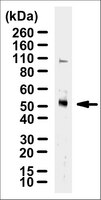Tumor necrosis factor receptor-associated factor 4 is a dynamic tight junction-related shuttle protein involved in epithelium homeostasis.
Kédinger, V; Alpy, F; Baguet, A; Polette, M; Stoll, I; Chenard, MP; Tomasetto, C; Rio, MC
PloS one
3
e3518
2008
Afficher le résumé
Despite numerous in vivo evidences that Tumor Necrosis Factor Receptor-Associated Factor 4 (TRAF4) plays a key biological function, how it works at the cellular and molecular level remains elusive.In the present study, we show using immunofluorescence and immuohistochemistry that TRAF4 is a novel player at the tight junctions (TJs). TRAF4 is connected to assembled TJs in confluent epithelial cells, but accumulates in the cytoplasm and/or nucleus when TJs are open in isolated cells or EGTA-treated confluent cells. In vivo, TRAF4 is consistently found at TJs in normal human mammary epithelia as well as in well-differentiated in situ carcinomas. In contrast, TRAF4 is never localized at the plasma membrane of poorly-differentiated invasive carcinomas devoid of correct TJs, but is observed in the cytoplasm and/or nucleus of the cancer cells. Moreover, TRAF4 TJ subcellular localization is remarkably dynamic. Fluorescence recovery after photobleaching (FRAP) experiments show that TRAF4 is highly mobile and shuttles between TJs and the cytoplasm. Finally, we show that intracellular TRAF4 potentiates ERK1/2 phosphorylation in proliferating HeLa cells, an epithelial cell line known to be devoid of TJs.Collectively, our data strongly support the new concept of TJs as a dynamic structure. Moreover, our results implicate TRAF4 in one of the emerging TJ-dependent signaling pathways that responds to cell polarity by regulating the cell proliferation/differentiation balance, and subsequently epithelium homeostasis. Drastic phenotypes or lethality in TRAF4-deficient mice and drosophila strongly argue in favor of such a function. | 18953416
 |
TRAF4 overexpression is a common characteristic of human carcinomas.
Camilleri-Broët, S; Cremer, I; Marmey, B; Comperat, E; Viguié, F; Audouin, J; Rio, MC; Fridman, WH; Sautès-Fridman, C; Régnier, CH
Oncogene
26
142-7
2007
Afficher le résumé
Tumor necrosis factor receptor (TNFR) associated factor 4 (TRAF4) was initially identified as a gene amplified and overexpressed in breast carcinomas. Our aim was to evaluate whether TRAF4 protein overexpression exists in other cancer types. Immunohistochemistry analysis of tumor samples from 623 patients with 20 different tumor types showed that TRAF4 was overexpressed in 268 tumors (43%), including 82 of 137 lung adenocarcinomas (60%). Interestingly, 32 primary tumors and their matching metastases exhibited mostly similar TRAF4 expression pattern. TRAF4 protein overexpression was limited to cancer cells and the subcellular localization was consistently cytoplasmic in a large majority of cases. To investigate changes in TRAF4 gene copy number, 125 cases from six different types of carcinomas were also analysed by fluorescence in situ hybridization. Out of the 28 cases (22%) showing an increased TRAF4 gene copy number, 23 (82%) were overexpressing the protein. Thus, TRAF4 gene amplification is one of the mechanisms responsible for TRAF4 protein overexpression in human cancers. Considering that TRAF4 is located at 17q11.2 in a region of amplification devoid of known oncogenes and is commonly overexpressed in cancer, our data support an oncogenic role for TRAF4. | 16799635
 |
Impaired neural tube closure, axial skeleton malformations, and tracheal ring disruption in TRAF4-deficient mice.
Régnier, CH; Masson, R; Kedinger, V; Textoris, J; Stoll, I; Chenard, MP; Dierich, A; Tomasetto, C; Rio, MC
Proceedings of the National Academy of Sciences of the United States of America
99
5585-90
2002
Afficher le résumé
TRAF4 belongs to the tumor necrosis factor receptor-associated factor (TRAF) family of proteins but, unlike other family members, has not yet been clearly associated to any specific receptor or signaling pathway. To investigate the biological function of TRAF4, we have generated traf4-deficient mice by gene disruption. The traf4 gene mutation is embryonic lethal but with great individual variation, as approximately one third of the homozygous mutant embryos died in utero around embryonic day 14, whereas the others reach adulthood. Surviving mutant mice manifest numerous developmental abnormalities; notably, 100% of homozygous mutant mice suffer respiratory disorder and wheezing caused by tracheal ring disruption. Additional malformations concern mainly the axial skeleton, as the ribs, sternum, tail, and vertebral arches are affected, with various degrees of penetrance. Traf4-deficient mice also exhibit a high incidence of spina bifida, a defect likened to neural tube defects (NTD) that are common congenital malformations in humans. Altogether, our results demonstrate that TRAF4 is required during embryogenesis in key biological processes including the formation of the trachea, the development of the axial skeleton, and the closure of the neural tube. Considering the normal expression pattern of TRAF4 in neural tissues, we can conclude that TRAF4 participates in neurulation in vivo. | 11943846
 |










